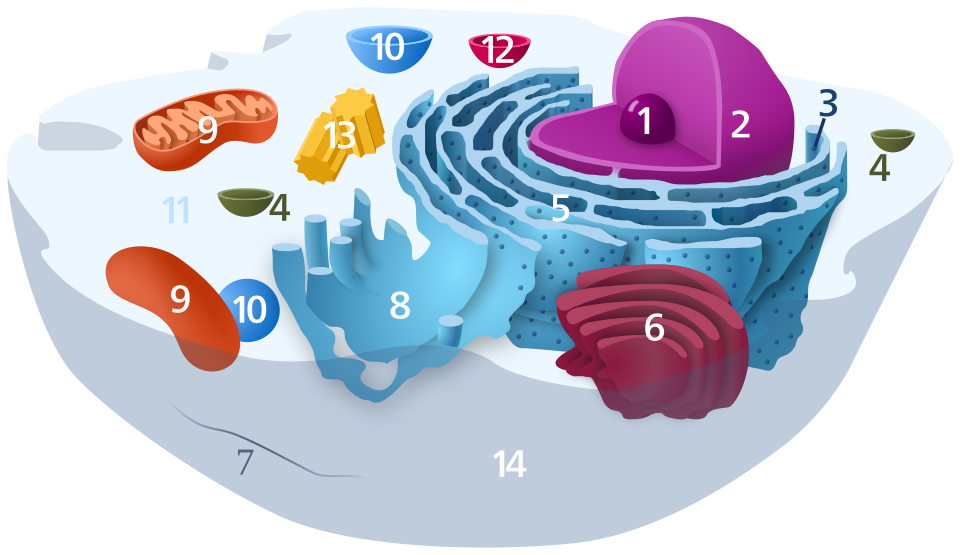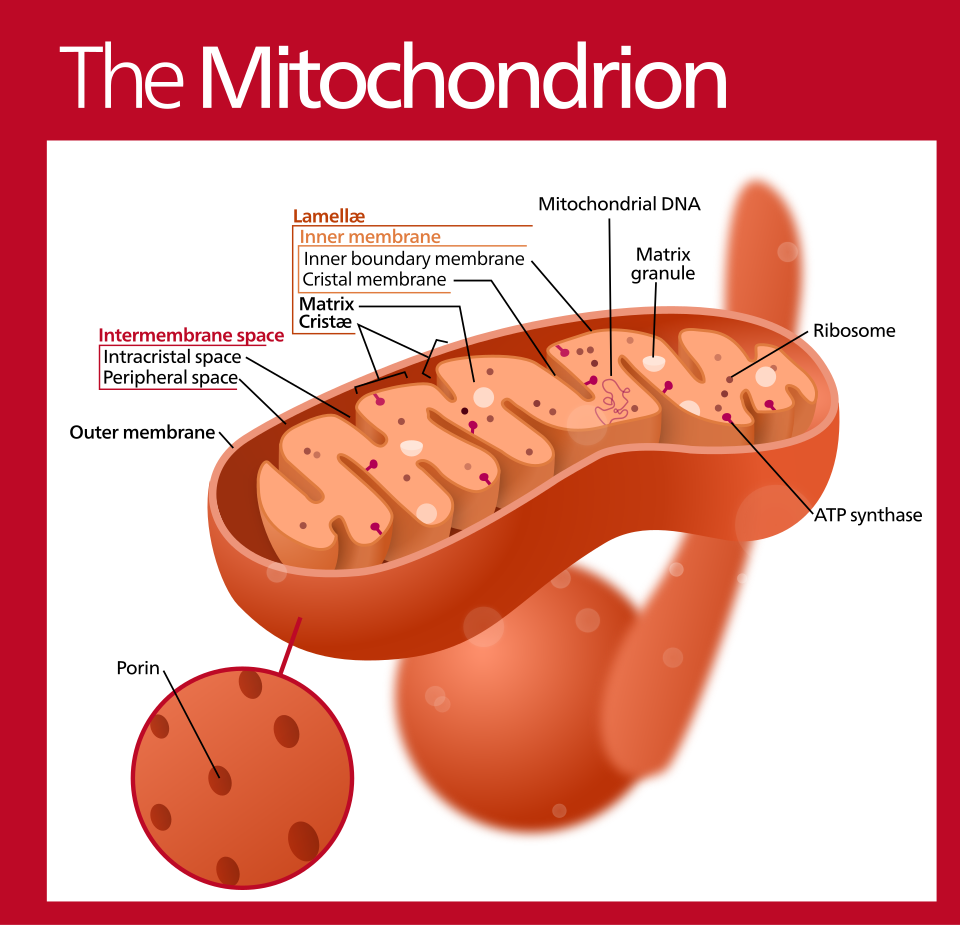OCR Specification focus:
‘Describe ultrastructure and functions of nucleus, ER, Golgi, ribosomes, mitochondria, chloroplasts and more.’
Eukaryotic cells contain numerous membrane-bound organelles that compartmentalise metabolic reactions and support complex cellular activity, enabling efficient coordination, communication, and specialised biochemical functions essential for life.
Eukaryotic Cell Ultrastructure
Eukaryotic cells possess an internal ultrastructure organised by membranes to create distinct environments for specific functions.

A schematic of a typical eukaryotic animal cell, showing the nucleus, rough and smooth endoplasmic reticulum, Golgi apparatus, ribosomes, mitochondria, lysosomes, and cytoskeleton. The diagram also shows the continuity between the nuclear envelope and rough ER. Extra organelles, such as peroxisomes, are shown beyond the syllabus but support wider context. Source.
Ultrastructure refers to the detailed cell organisation visible under electron microscopes, which provide the resolution needed to study organelles in depth. The cytoplasm contains organelles suspended in cytosol, supported by the cytoskeleton for stability and intracellular movement.
The Nucleus and Genetic Control
The nucleus is the largest organelle and is essential for storing and controlling the use of genetic information.
Nucleus: A membrane-bound organelle containing chromatin and responsible for regulating gene expression and cell activity.
It is enclosed by the nuclear envelope, a double membrane containing nuclear pores to regulate exchange with the cytoplasm. Inside is the nucleolus, which synthesises ribosomal RNA (rRNA). DNA associates with proteins to form chromatin, condensing into chromosomes during cell division.
Endoplasmic Reticulum (ER)
The endoplasmic reticulum forms a network of flattened sacs called cisternae.
Rough ER (RER) has ribosomes on its surface and is involved in protein synthesis and folding.
Smooth ER (SER) lacks ribosomes and synthesises lipids and steroids, also detoxifying metabolic by-products.
Proteins produced on RER-bound ribosomes are packaged into vesicles and sent to the Golgi apparatus.
Ribosomes and Protein Production
Ribosomes are small, non-membrane-bound structures composed of rRNA and protein. They can occur freely in the cytoplasm or on the RER.
Ribosome: A cellular structure that assembles amino acids into polypeptides during translation.
Cytoplasmic ribosomes produce intracellular proteins, while ribosomes on the RER produce proteins for secretion or membrane insertion.
Golgi Apparatus and Secretion
The Golgi apparatus modifies, folds, and packages proteins into secretory vesicles. These vesicles can:
fuse with the plasma membrane for exocytosis
form lysosomes
transport membrane proteins to their destination
The Golgi is essential for producing glycoproteins and ensuring proteins are correctly processed and distributed.
Mitochondria and Aerobic Respiration
Mitochondria are the site of aerobic respiration and ATP production.

A labelled mitochondrion showing the outer membrane, folded inner membrane (cristae), matrix, and intermembrane space. The folds provide a large surface area for ATP-producing enzymes. This visual directly supports the role of mitochondria in aerobic respiration. Source.
They have a double membrane, with the inner membrane folded into cristae, increasing surface area for ATP synthesis. The matrix contains enzymes, ribosomes, and mitochondrial DNA, allowing limited self-replication. Cells with high energy demands contain many mitochondria.
Chloroplasts and Photosynthesis
In plant cells, chloroplasts carry out photosynthesis. They have a double membrane and internal stacks of membranes called grana, linked by lamellae and surrounded by the stroma. Chloroplasts contain chlorophyll pigments and their own DNA. Reactions of photosynthesis occur across both grana membranes and in the stroma.
Lysosomes and Hydrolytic Enzymes
Lysosomes are vesicles containing digestive enzymes that break down unwanted organelles, pathogens, and macromolecules. They play key roles in apoptosis and cellular recycling.
The Cytoskeleton
The cytoskeleton is a network of microtubules, microfilaments, and intermediate fibres that:
maintain cell shape
enable organelle movement
form the spindle during cell division
facilitate cell motility through structures such as cilia and flagella
Plasma Membrane and Compartmentalisation
The plasma membrane is a partially permeable barrier that separates the cell from its environment and controls molecular exchange. Internal membranes create compartments for specialised metabolic pathways, preventing harmful interactions and improving efficiency.
Vesicles and Transport Pathways
Small vesicles transport substances between organelles. Key routes include:
RER → Golgi apparatus → plasma membrane
Golgi apparatus → lysosomes
Endocytosis-derived vesicles → lysosomes for digestion
Vacuoles and Cell Support
Plant cells possess a large central vacuole containing cell sap. It maintains turgor pressure for structural support. Animal cells may have small, temporary vacuoles.
Cell Wall in Plants and Fungi
Plant cells have a cellulose cell wall providing strength and preventing osmotic lysis. Fungal cell walls contain chitin. These structures also act as barriers against pathogens.
Summary of Key Organelle Functions
Bullet-point clarity for rapid learning:
Nucleus: genetic control and RNA formation
ER: RER for protein synthesis; SER for lipid synthesis
Ribosomes: polypeptide assembly
Golgi: protein modification and secretion
Mitochondria: aerobic respiration and ATP production
Chloroplasts: photosynthesis in plants
Lysosomes: intracellular digestion
Cytoskeleton: structure and movement
Plasma membrane: selective barrier
Vacuole: turgor maintenance
Cell wall: strength and protection
FAQ
Nuclear pores contain a selective protein structure called the nuclear pore complex, which only allows molecules with the correct recognition signals to pass through.
Small molecules diffuse freely, but larger molecules such as mRNA or proteins require transport proteins.
Importins move substances into the nucleus
Exportins move substances out of the nucleus
This system maintains control of gene expression by regulating what can interact with nuclear DNA.
These organelles are thought to have originated from free-living prokaryotes through endosymbiosis. Their DNA enables them to make some of their own proteins independently of the cell’s nucleus.
This allows rapid synthesis of key respiratory or photosynthetic proteins, which is advantageous for responding to energy demands.
Free ribosomes produce proteins that will stay in the cytoplasm, nucleus, mitochondria or chloroplasts.
RER-bound ribosomes produce proteins destined for:
secretion outside the cell
insertion into membranes
packaging into organelles such as lysosomes
The Golgi uses enzymes to make structural changes that ensure each protein folds correctly and reaches the right destination.
Common modifications include:
adding carbohydrate groups to form glycoproteins
removing amino acids or combining polypeptide chains
packaging proteins into vesicles for transport
Microtubules act as intracellular “tracks” along which vesicles and organelles can be moved. Motor proteins such as dynein and kinesin use ATP to “walk” along these structures.
This system enables directed transport, helps position organelles and supports changes in cell shape, especially during cell division.
Practice Questions
Question 1 (2 marks)
Name two membrane-bound organelles found in a eukaryotic cell and state one function for each.
Question 1 (2 marks)
One mark for each correct organelle with a matching correct function.
Accept any two of the following (or other valid examples):
Nucleus: stores genetic material or controls cell activities (1)
Mitochondrion: site of aerobic respiration or ATP production (1)
Golgi apparatus: modifies and packages proteins (1)
Rough ER: synthesises and folds proteins (1)
Lysosome: contains hydrolytic enzymes to break down waste (1)
Maximum 2 marks.
Question 2 (5 marks)
Describe the roles of the nucleus, rough endoplasmic reticulum, Golgi apparatus and ribosomes in the production and secretion of proteins in eukaryotic cells.
Question 2 (5 marks)
One mark per valid point, up to 5 marks:
Nucleus contains DNA which codes for the polypeptide (1)
Transcription produces mRNA, which leaves the nucleus via nuclear pores (1)
Ribosomes read mRNA to synthesise the polypeptide during translation (1)
Rough ER folds and processes the polypeptide and transports it in vesicles (1)
Golgi apparatus modifies and packages proteins into secretory vesicles for exocytosis (1)

